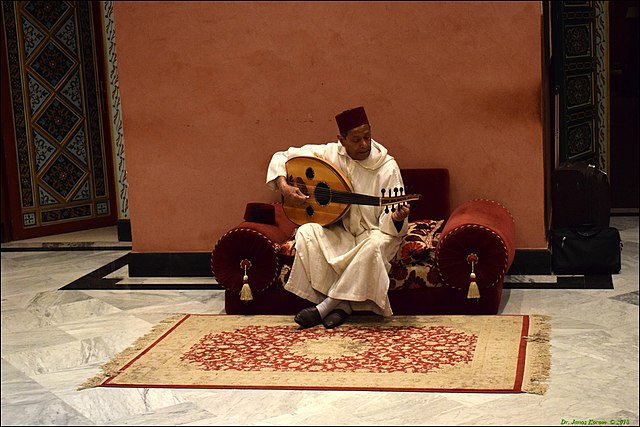Echoes of Al-Andalus: Harmonizing Morocco and Spain

By: Nissrine Bedda / Arab America Contributing Writer
Around 13 kilometers apart lie the borders of Tangier, Morocco, and Sevilla, Spain—marking the gateway to Andalusian culture and the beginning of an extraordinary tale of exchange between East and West. The origins of Andalusi classical music trace back to the 9th century in the region of Al-Andalus, particularly in Córdoba, Spain. A musician known as Ziryab arrived to these lands to escape tensions in the court of Baghdad…Ziryab introduced in Al-Andalus oriental harmonies of Greek-Persian origin where the seeds of the traditional music that were to appear later were shown. His contribution was especially important because he minimized improvisation in both rhythm and mode, which was a recurring practice when it comes to performing Arab-Andalusian song, and he established a series of premises to allow this art to be even more recognized.
This was a time when the landscape was adorned with grand arches, intricate Moroccan tilework, and a unique blend of Arabic and Spanish languages that came together to share stories, art, and, above all, music. Andalusi music represents more than just a fusion of diverse melodic traditions; it carries deep cultural significance, reflecting a history of rich diplomatic exchanges. This legacy is still honored and cherished by people today, resonating as a symbol of enduring cultural harmony.
The Rise of Andalusi Orchestra
Dating back to the 10th century, Muslim Iberia was considered to be the region of focus as instrumental manufacturers had situated themselves in the region. From guitars to castanets, to the emergence of the oud in the West to the naqareh, percussion set; the merging of musical instruments allowed for the diverse minds of musicians to flourish with experimentation and cultural elements that would evidently bring the community together through dance and melody to cherish one another.
Fluidity and Experimentation
The classical elements of Andalusi music, combined with the dynamics of the Spanish guitar, set this genre apart from other poetic musical forms, like the muwashshaḥ, which emphasizes a poetic structure of five stanzas. Interestingly, North Africans often approach the Arabic meter with a more relaxed attitude, contrasting with the stricter adherence found among Arabs in the East. Andalusi Romance, Hebrew, and other Romance languages—reflect the fluidity and diversity of the linguistic landscape of al-Andalus. And maybe it’s due to that level of fluidity, that makes Andalusi music so distinct from other Arabic classical genres that allows the mind to flourish creating an area of experimentation, almost like the improvisation of classic jazz music.
Since the 10th century, Morocco has integrated Andalusi music into its culture, using it as a form of cultural diplomacy to honor its historical ties with neighboring Spain. Despite the complexities of their current geopolitical relationship, Morocco continues to celebrate this shared heritage, particularly during occasions like Eid festivities and weddings, highlighting the enduring fusion of their cultures. The classical genre sparks nostalgia for the diaspora when listening to the sounds that remind them of back home. From the strum of the oud to the beat of the drum, the symphonic elements combined allow your body to disconnect from the present and submerge yourself back to the bled (“homeland” in Darija).
The format of the orchestra is an aspect that ties the music and cultural ties together to mark a performance that allows you to submerge yourself in the Moroccan-Andalusian culture and capture its essence. Typically, you can find the orchestra scattered based on instrumental categorization. In other words, the kamenjah (“violin” in Arabic) stands as one of the most prominent instruments shaping Andalusi music. Violinists are often positioned at the forefront of the orchestra, leading the ensemble while honoring tradition by wearing the djellaba. The smooth, serene tones of the strings evoke a sense of nostalgia, transporting listeners back to Spain and echoing the timeless essence of classic flamenco that still resonates in the Andalusian region.
Cultural Influence Leads Diplomacy
The blending of Eastern and Western influences draws a diverse audience to appreciate the timeless classical elements that define what we now celebrate as modern-day Andalusia. Morocco continues to seamlessly weave its cultural threads into the fabric of Spanish heritage, allowing the nation to embrace its rich history, vibrant artistic traditions, and diverse cultural expressions. These musical elements that have continued to be passed down through centuries continue to replay through Moroccan customs and traditions that allow for current generations to recognize, remix, and incorporate Andalusi music into their daily lives that will follow for generations ahead.
Check out our blog!









